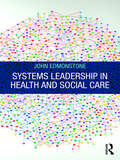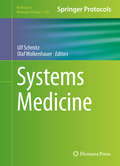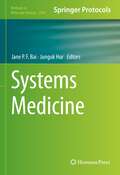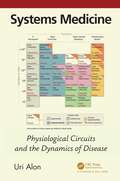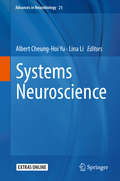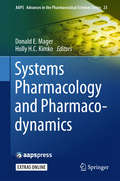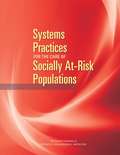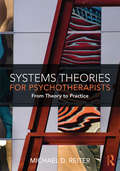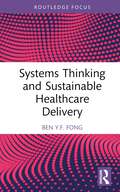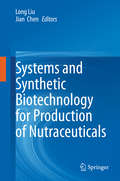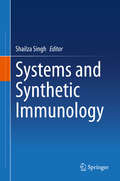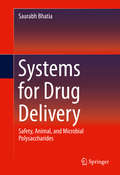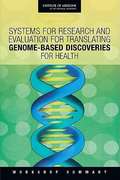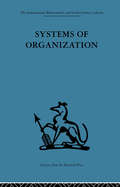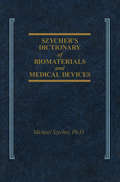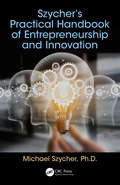- Table View
- List View
Systems Leadership in Health and Social Care
by John EdmonstoneMost leadership development activity in health and social care has been intra-organisational or confined to a particular sector. However, there is increasing recognition of the need to move beyond simple collaboration and partnership and work towards different models of care which involve addressing the whole health and social care system. This is particularly important when addressing complex and 'wicked' problems in a time of resource scarcity. This book provides a much-needed guide for individuals, professionals, and organisations making the shift towards working in radically different ways in this current climate. It provides a rationale for systems leadership, describing the basic underlying principles behind it and their origins, and explores the various aspects of it, with particular emphasis on the development of systems leaders in health and social care. It also captures good practice, which is illustrated by a number of case studies, and suggests further reading on the topic. Combining theory with practice, this book will be essential reading for those studying on courses in public service, public policy, health and social care, as well as policymakers and professionals interested in honing best practice.
Systems Medicine
by Ulf Schmitz Olaf WolkenhauerThis volume guides readers through the field of systems medicine by defining the terminology, and describing how established computational methods form bioinformatics and systems biology can be taken forward to an integrative systems medicine approach. Chapters provide an outlook on the role that systems medicine may or should play in various medical fields, and describe different facets of the systems medicine approach in action. Ultimately it introduces tools, resources and methodologies from bioinformatics and systems biology, and how to apply these in a systems medicine project. Written for the Methods in Molecular Biology series, chapters include introductions to their respective topics, and discuss experimental and computational approaches, methods, and tools that should be considered for a successful systems medicine project. Systems Medicine aims to motivate and provide guidance for collaborations across disciplines to tackle today's challenges related to human health and well-being.
Systems Medicine (Methods in Molecular Biology #2486)
by Jane P. F. Bai Junguk HurThis volume explores the latest technological advances and covers all facets of systems medicine with respect to precision medicine. The chapters in this book are organized into four parts. Part One highlights the recent achievements in proteomics for biomarkers identification, integration of omics and phenotypic data for precision medicine, and medicine-guided treatment of drug-induced Stevens-Johnson syndrome. Part Two covers systems-based computational approaches for pharmaceutical research and drug development, the principle of optimizing systemic exposure of drugs, and Animal Rule for drug repurposing. Part Three looks at computational tools and methodologies of network biology, quantitative systems toxicology, and modeling and stimulating patient response variabilities. Part Four talks about how systems medicine can address unmet medical and health needs, and identify educational needs. Written in the highly successful Methods in Molecular Biology series format, chapters include introductions to their respective topics, lists of the necessary materials and reagents, step-by-step, readily reproducible laboratory protocols, and tips on troubleshooting and avoiding known pitfalls.Cutting-edge and thorough, Systems Medicine: Methods and Protocols is a valuable resource for the scientific community that will help researchers work together toward the further advancement of achieving the goal of promoting global health.Chapter 8 is available open access under a Creative Commons Attribution 4.0 International License via link.springer.com
Systems Medicine: Physiological Circuits and the Dynamics of Disease (Chapman & Hall/CRC Computational Biology Series)
by Uri AlonWhy do we get certain diseases, whereas other diseases do not exist? In this book, Alon, one of the founders of systems biology, builds a foundation for systems medicine. Starting from basic laws, the book derives why physiological circuits are built the way they are. The circuits have fragilities that explain specific diseases and offer new strategies to treat them. By the end, the reader will be able to use simple and powerful mathematical models to describe physiological circuits. The book explores, in three parts, hormone circuits, immune circuits, and aging and age-related disease. It culminates in a periodic table of diseases. Alon writes in a style accessible to a broad range of readers - undergraduates, graduates, or researchers from computational or biological backgrounds. The level of math is friendly and the math can even be bypassed altogether. For instructors and readers who want to go deeper, the book includes dozens of exercises that have been rigorously tested in the classroom
Systems Metabolic Engineering
by Sang Yup Lee Christoph WittmannSystems Metabolic Engineering is changing the way microbial cell factories are designed and optimized for industrial production. Integrating systems biology and biotechnology with new concepts from synthetic biology enables the global analysis and engineering of microorganisms and bioprocesses at super efficiency and versatility otherwise not accessible. Without doubt, systems metabolic engineering is a major driver towards bio-based production of chemicals, materials and fuels from renewables and thus one of the core technologies of global green growth. In this book, Christoph Wittmann and Sang-Yup Lee have assembled the world leaders on systems metabolic engineering and cover the full story - from genomes and networks via discovery and design to industrial implementation practises. This book is a comprehensive resource for students and researchers from academia and industry interested in systems metabolic engineering. It provides us with the fundaments to targeted engineering of microbial cells for sustainable bio-production and stimulates those who are interested to enter this exiting research field.
Systems Neuroscience (Advances in Neurobiology #21)
by Albert Cheung-Hoi Yu Lina LiThis edition of Advances in Neurobiology brings together experts in the emerging field of Systems Neuroscience to present an overview of this area of research. Topics covered include: how different neural circuits analyze sensory information, form perceptions of the external world, make decisions, and execute movements; how nerve cells behave when connected together to form neural networks; the relationship between molecular and cellular approaches to understanding brain structure and function; the study of high-level mental functions; and studying brain pathologies and diseases with Systems Neuroscience. A hierarchy of biological complexity arises from the genome, transcriptome, proteome, organelles, cells, synapses, circuits, brain regions, the whole brain, and behaviour. The best way to study the brain, the most complex organ in the body composed of 100 billion cells with trillions of interconnections, is with a Systems Biology approach. Systems biology is an inter-disciplinary field that focuses on complex interactions within biological systems to reveal 'emergent properties' - properties of cells and groups of cells functioning as a system whose actual and theoretical description is only possible using Systems Biology techniques.
Systems Neuroscience and Rehabilitation
by Leonardo Cohen Kenji KansakuRapidly growing knowledge in systems neuroscience may contribute to expand the range of activities in persons with disabilities, but in its practical application, cooperation between experts in different research fields is necessary. In this conference, the guest speakers and audiences will be from wide range of research fields; e.g., systems-neuroscience, neurology, engineering, psychology, and the attendees will discuss the possibilities.
Systems Orthodontics: From Clinical Reasoning to Computation, and Back (Understanding Complex Systems)
by Guido Caldarelli Pietro Auconi Antonella PolimeniThis book marks one of the first applications of the Medicine Network discipline to an everyday scenario. It explores situations where patients, often in adolescence, grapple with the decision of whether to commence a treatment, seeking insights into the more plausible future scenarios. Additionally, the specific feedback from biological systems in the human body serves as a potent metaphor for addressing various challenges in the field of Complex Systems. In recent times, systems thinking and complexity theory have yielded substantial conceptual advancements across various research domains. In the context of orthodontics, these approaches offer a more comprehensive understanding in contrast to the traditional mechanistic approach, which primarily focuses on the analysis of applied forces. Systems thinking directs attention to the interaction among dentoskeletal components, where the behavior of one element can influence others. The amalgamation of multiple elements leads to entities with properties distinct from those of individual components. The increasing complexity of orthodontic reality beyond clinical or radiological observations necessitates the development of new theories. Complexity theory has demonstrated that emergent properties in biological systems can be discerned through appropriate computational models, as opposed to the analytical study of individual components. The central metaphor for the interactive craniofacial system during growth is portrayed by the facial topology revealed through network analysis, facilitating a systemic reevaluation of traditional orthodontic theories. This book delineates the novel insights derived from the clinical-computational approach, applicable for a prognostic and early interception perspective in managing dentofacial dysmorphoses. Its objective is to captivate practitioners and persuade them of the practical utility of these innovative approaches.
Systems Pharmacology and Pharmacodynamics
by Donald E. Mager Holly H.C. KimkoWhile systems biology and pharmacodynamics have evolved in parallel, there are significant interrelationships that can enhance drug discovery and enable optimized therapy for each patient. Systems pharmacology is the relatively new discipline that is the interface between these two methods. This book is the first to cover the expertise from systems biology and pharmacodynamics researchers, describing how systems pharmacology may be developed and refined further to show practical applications in drug development. There is a growing awareness that pharmaceutical companies should reduce the high attrition in the pipeline due to insufficient efficacy or toxicity found in proof-of-concept and/or Phase II studies. Systems Pharmacology and Pharmacodynamics discusses the framework for integrating information obtained from understanding physiological/pathological pathways (normal body function system vs. perturbed system due to disease) and pharmacological targets in order to predict clinical efficacy and adverse events through iterations between mathematical modeling and experimentation.
Systems Practices for the Care of Socially At-Risk Populations
by Engineering Medicine National Academies of SciencesThe Centers for Medicare & Medicaid Services (CMS) have been moving from volume-based, fee-for-service payment to value-based payment (VBP), which aims to improve health care quality, health outcomes, and patient care experiences, while also controlling costs. Since the passage of the Patient Protection and Affordable Care Act of 2010, CMS has implemented a variety of VBP strategies, including incentive programs and risk-based alternative payment models. Early evidence from these programs raised concerns about potential unintended consequences for health equity. Specifically, emerging evidence suggests that providers disproportionately serving patients with social risk factors for poor health outcomes (e.g., individuals with low socioeconomic position, racial and ethnic minorities, gender and sexual minorities, socially isolated persons, and individuals residing in disadvantaged neighborhoods) may be more likely to fare poorly on quality rankings and to receive financial penalties, and less likely to receive financial rewards. The drivers of these disparities are poorly understood, and differences in interpretation have led to divergent concerns about the potential effect of VBP on health equity. Some suggest that underlying differences in patient characteristics that are out of the control of providers lead to differences in health outcomes. At the same time, others are concerned that differences in outcomes between providers serving socially at-risk populations and providers serving the general population reflect disparities in the provision of health care. Systems Practices for the Care of Socially At-Risk Populations seeks to better distinguish the drivers of variations in performance among providers disproportionately serving socially at-risk populations and identifies methods to account for social risk factors in Medicare payment programs. This report identifies best practices of high-performing hospitals, health plans, and other providers that serve disproportionately higher shares of socioeconomically disadvantaged populations and compares those best practices of low-performing providers serving similar patient populations. It is the second in a series of five brief reports that aim to inform the Office of the Assistant Secretary of Planning and Evaluation (ASPE) analyses that account for social risk factors in Medicare payment programs mandated through the Improving Medicare Post-Acute Care Transformation (IMPACT) Act.
Systems Theories for Psychotherapists: From Theory to Practice
by Michael D. Reiter<p><i>Systems Theories for Psychotherapists</i> explores three key theories that underpin many of the models of psychotherapy: general systems theory, natural systems theory, and language systems theory. The book presents the aesthetics (how to see and understand what is happening) and the pragmatics (what to do in the therapy room) behind each theory. It also explores how therapists can successfully conceptualize the problems that clients bring to therapy, offering a range of contemporary examples to show how each theory can be applied to practice. <p>Starting with an introduction to systems theories, the book then delves into cybernetics, interactional systems, natural systems, constructivist theory, and social construction theory. Each chapter uses a distinctive case example to help clinicians to better understand and apply the theories to their own therapeutic setting. Woven throughout the book are three helpful learning tools: "Applying Your Knowledge," "Key Figure," and "Questions for Reflection," providing the reader with the opportunity to critically engage with each concept, consider how their own world view and preconceptions can inform their work with clients, and challenging them to apply prominent systems theories to their own practice. <p><i>Systems Theories for Psychotherapists</i> is a clear and valuable text for undergraduate and graduate students in mental health programs, including counseling, marriage and family therapy, social work and clinical psychology, as well as for all practicing clinicians.</p>
Systems Theory and the Sociology of Health and Illness: Observing Healthcare
by Werner Vogd Morten KnudsenModern societies and organizations are characterized by multiple kinds of observations, systems, or rationalities, rather than singular identities and clear hierarchies. This holds true for healthcare where we find a range of different perspectives – from medicine to education, from science to law, from religion to politics – brought together in different types of arrangements. This innovative volume explores how this polycontexturality plays out in the healthcare arena. Drawing on systems theory, and Luhmann’s theory of social systems as communicative systems in particular, the contributors investigate how things – drugs, for example – and bodies are observed and constructed in different ways under polycontextural conditions. They explore how the different types of communication and observation are brought into workable arrangements – without becoming identical or reconciled – and discuss how health care organizations observe their own polycontexturality. Providing an analysis of healthcare structures that is up to speed with the complexity of healthcare today, this book shows how society and its organizations simultaneously manage contexts that do not fit together. It is an important work for those with an interest in health and illness, social theory, Niklas Luhmann, organizations and systems theory from a range of backgrounds including sociology, health studies, political science and management.
Systems Thinking and Sustainable Healthcare Delivery (Routledge Focus on Business and Management)
by Ben Y.F. FongThe Sustainable Development Goal 3 seeks to ensure health and well-being for all at every stage of life. This book discusses how to strengthen our healthcare systems and ensure sustainable community healthcare delivery by using systems thinking, an approach to understanding complex interactions of individual system elements in nature. Financing and manpower planning are integral processes to achieve health for all in the world. Adopting the Framework for Action of the World Health Organization for Strengthening Health Systems to Improve Health Outcomes, this book reviews and discusses, illustrated by case examples, the building blocks of healthcare systems, namely financing, human resources, management strategies and leadership and governance in the context of accessibility, coverage, quality and safety of community health services to achieve selected targets in SDG 3 in the context of global health. This book will be of interest to those who are researching sustainable healthcare systems, as well as policymakers and healthcare professionals.
Systems and Synthetic Biotechnology for Production of Nutraceuticals
by Jian Chen Long LiuThis book discusses systems and synthetic biotechnologies for the production of nutraceuticals, and summarizes recent advances in nutraceutical research in terms of the physiological effects on health, potential applications, drawbacks of traditional production processes, characteristics of production strains, and advances in microbial production based on systems and synthetic biotechnology. It also examines future directions in the microbial production of nutraceuticals using systems and synthetic biology. The book is intended for researchers and graduate students in the field of molecular biology and industrial biotechnology as well as staff working in the nutraceutical industry.
Systems and Synthetic Immunology
by Shailza SinghSystems and Synthetic Immunology focuses on the similarities between biology and engineering at the systems level, which are important for applying engineering theories to biology problems. With the advent of new genomic techniques, there are numerous systematic investigations underway in the scientific world. This volume highlights techniques that can be used to effectively combine two of the most essential biological fields - Systems Biology and Synthetic Immunology.The respective chapters discuss the role of synthetic immunology in biotechnology, production of biomaterials, and their use in vaccine delivery. Further topics include the importance of cytokines; the use of genomic engineering tools in immunotherapy; immunosensors; nanotherapeutics; and bioinformatics tools in biomedical applications. Given its scope, the book offers readers an up-to-date and comprehensive review of this unique and dynamic field of research.
Systems for Drug Delivery
by Saurabh BhatiaThis book details current developments in all natural polymers, with a focus on animal and microbial polysaccharides. The book examines, compares, and contrasts the efficiency of plant and algae based natural polymers in inducing immune reactions. Additionally, the book details the safety and toxicity profiles with respective regulations.
Systems for Research and Evaluation for Translating Genome-Based Discoveries for Health: Workshop Summary
by Institute of Medicine of the National AcademiesWith the advent of genome-wide association studies, numerous associations between specific gene loci and complex diseases have been identified--for breast cancer, coronary artery disease, and asthma, for example. This rapidly advancing field of genomics has stirred great interest in "personalized" health care from both the public and private sectors. The hope is that using genomic information in clinical care will lead to reduced health care costs and improved health outcomes as therapies are tailored to the genetic susceptibilities of patients. A variety of genetically based health care innovations have already reached the marketplace, but information about the clinical use of these treatments and diagnostics is limited. Currently data do not provide information about how a genomic test impacts clinical care and patient health outcomes--other approaches are needed to garner such information. This volume summarizes a workshop to address central questions related to the development of systems to evaluate clinical use of health care innovations that stem from genome-based research: What are the practical realities of creating such systems? What different models could be used? What are the strengths and weaknesses of each model? How effectively can such systems address questions about health outcomes?
Systems of Organization: The control of task and sentient boundaries
by A K Rice E J MillerTavistock Press was established as a co-operative venture between the Tavistock Institute and Routledge & Kegan Paul (RKP) in the 1950s to produce a series of major contributions across the social sciences. This volume is part of a 2001 reissue of a selection of those important works which have since gone out of print, or are difficult to locate. Published by Routledge, 112 volumes in total are being brought together under the name The International Behavioural and Social Sciences Library: Classics from the Tavistock Press. Reproduced here in facsimile, this volume was originally published in 1967 and is available individually. The collection is also available in a number of themed mini-sets of between 5 and 13 volumes, or as a complete collection.
Szycher's Dictionary of Biomaterials and Medical Devices
by Michael SzycherThis dictionary contains thousands of definitions from various related disciplines and minimizes the need for several dictionaries. The book defines everything from AAMI (Association for the Advancement of Medical Instrumentation) to zymogen (proenzyme). The editor, an internationally recognized expert in the area of biomaterials, has combined knowledge from the fields of medicine, pharmacology, physiology, polymer chemistry, biochemistry, metallurgy, and organic chemistry.
Szycher's Dictionary of Medical Devices
by Michael SzycherFROM THE PREFACEThe field of medical devices represents one of the most advanced technological areas in the United States. In 1991, over 12 million Americans had at least one medical device; fixation devices had the highest incidence, followed by contact lens use and lens implants and, lastly, artificial joints. The public has come to expect that medical devices will alleviate maladies and/or conditions that were not treatable fifty years ago. It is hard to believe that the first pacemaker was invented in the 1950s, the first artificial heart valve in 1952, and the first artificial hip replacement was performed in 1954. In 1992, the medical device industry exported a total of $6.9 billion, while the country imported a total of $3.9 billion, representing a $3.0 billion trade surplus. Medical devices are among the most regulated products in the world. The FDA maintains a constant vigil over medical device manufacturers and importers; even medical device definitions are subject to official scrutiny. Title 21 of the Code of Federal Regulations publishes these definitions, but the definitions are spread over several medical specialty areas and are, thus, difficult to find. This book attempts to bring a measure of order by providing an alphabetical listing of officially defined devices.
Szycher's Handbook of Polyurethanes
by Michael SzycherA practical handbook rather than merely a chemistry reference, Szycher's Handbook of Polyurethanes, Second Edition offers an easy-to-follow compilation of crucial new information on polyurethane technology, which is irreplaceable in a wide range of applications. This new edition of a bestseller is an invaluable reference for technologists, marketer
Szycher’s Practical Handbook of Entrepreneurship and Innovation
by Michael SzycherThis practical and comprehensive handbook offers step-by-step instruction, guiding entrepreneurs of innovative technology startups all the way from idea to profitability. With its easy-to-follow format aimed at both experienced as well as novice entrepreneurs, this book covers all technical, financial, legal, and governmental hurdles facing startups. It discusses common causes of business failure and points out the pitfalls to avoid in getting innovative technology successfully to market.
SÍNDROME DA FADIGA CRÔNICA: UM GUIA DE TRATAMENTO, SEGUNDA EDIÇÃO
by Erica Verrillo Sueli ZardoEssas informações exclusivas – agora completamente revisadas e atualizadas – incluem mais de 100 tratamentos eficazes, desde antivirais até vitaminas, bem como locais de especialistas e clínicas, informações para comprar pela Internet e organizações nacionais, locais e internacionais sobre a SFC/EM. Seções novas e ampliadas incluem protocolos e pesquisas de médicos sobre as causas e mecanismos da doença, todos escritos em linguagem concisa e fácil de entender. Cada aspecto da doença é examinado detalhadamente, do diagnóstico a uma discussão profunda dos sintomas, de terapias tradicionais à alternativas até estratégias essenciais para lidar com a doença. A nova edição contém capítulos para pessoas lidando com sensibilidades a vários produtos químicos e restrições alimentares, bem como uma seção ampliada sobre crianças e adolescentes com a SFC/EM. Síndrome da Fadiga Crônica: Um Guia de Tratamento, segunda edição, ainda é o guia de referência mais completo sobre essa doença.
Säuren-Basen-Haushalt: Azidosen und Alkalosen verstehen, erkennen und behandeln
by Frank WaltherDieses Buch beinhaltet Grundlagen, Diagnostik und Therapie von Störungen des Säuren-Basen-Haushalts.Wer sich dafür interessiert, wie eine diabetische Ketoazidose entsteht, wie man sie behandelt, welchen Stellenwert die Therapie mit Puffersubstanzen bei Störungen des Säuren-Basen-Haushaltes hat, wie sich eine Hypothermie auf den Säuren-Basen-Haushalt auswirkt, was eine posthyperkapnische Alkalose ist, oder wer wissen möchte, wodurch sich BE- und Standardbikarbonat-Wert im Säuren-Basen-Status unterscheiden, findet die Erklärungen und Grundlagen dafür und noch etliches mehr in diesem Buch. Neben Kapiteln, die sich mit den weitgehend unveränderlichen Grundlagen und Grundsätzen der therapeutischen Möglichkeiten beschäftigen bzw. für Bereiche mit noch unzureichender Evidenzgrundlage die aktuell führenden Expertenmeinungen wiedergeben, werden zur Veranschaulichung 12 klinische Fälle präsentiert, an deren Beispiel die diagnostische Vorgehensweise bei unterschiedlichen Säuren-Basen-Störungen und die klinischen bzw. therapeutischen Schlussfolgerungen erläutert werden. Ziel des Buches ist die Vermittlung von fundiertem und doch praxisrelevanten, am Krankenbett einsetzbaren Wissen auf der Grundlage des Wissens aus der Biochemie und Physiologie-Ausbildung des Physikums. Es wendet sich an Ärztinnen und Ärzte verschiedener Facharztausbildungen sowie Medizinstudentinnen und -studenten.
Säuren-Basen-Haushalt: Azidosen und Alkalosen verstehen, erkennen und behandeln
by Frank WaltherDieses Buch beinhaltet Grundlagen, Diagnostik und Therapie von Störungen des Säuren-Basen-Haushalts. Wer sich dafür interessiert, wie eine diabetische Ketoazidose entsteht, wie man sie behandelt, welchen Stellenwert die Therapie mit Puffersubstanzen bei Störungen des Säuren-Basen-Haushaltes hat, wie sich eine Hypothermie auf den Säuren-Basen-Haushalt auswirkt, was eine posthyperkapnische Alkalose ist, oder wer wissen möchte, wodurch sich BE- und Standardbikarbonat-Wert im Säuren-Basen-Status unterscheiden, findet die Erklärungen und Grundlagen dafür und noch etliches mehr in diesem Buch. Neben Kapiteln, die sich mit den weitgehend unveränderlichen Grundlagen und Grundsätzen der therapeutischen Möglichkeiten beschäftigen bzw. für Bereiche mit noch unzureichender Evidenzgrundlage die aktuell führenden Expertenmeinungen wiedergeben, werden zur Veranschaulichung 12 klinische Fälle präsentiert, an deren Beispiel die diagnostische Vorgehensweise bei unterschiedlichen Säuren-Basen-Störungen und die klinischen bzw. therapeutischen Schlussfolgerungen erläutert werden. Ziel des Buches ist die Vermittlung von fundiertem und praxisrelevanten, am Krankenbett einsetzbaren Wissen auf der Grundlage des Wissens aus der Biochemie und Physiologie-Ausbildung des Physikums. Es wendet sich an Ärztinnen und Ärzte verschiedener Facharztausbildungen sowie Medizinstudentinnen und -studenten. In der 2. Auflage wurde das Buch sorgfältig überarbeitet und aktualisiert und um neue Informationen ergänzt, z. B. zum Kalzium-Phosphat-Haushalt und zur 2022 erschienenen neuen Leitlinie für die Behandlung der diabetischen Ketoazidose im Kindesalter.
